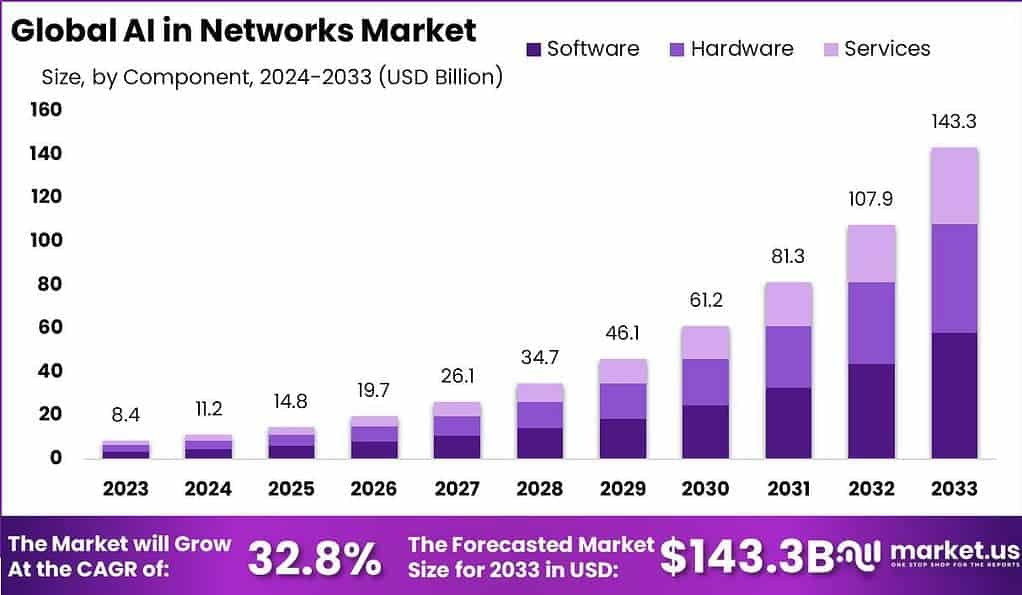Introduction:
The global AI in networks market was valued at approximately USD 5.8 billion in 2024 and is projected to reach USD 24.1 billion by 2030, growing at a CAGR of over 26.7%. This growth is driven by rising network complexities, increasing data traffic, and demand for automation in telecom and enterprise infrastructure. AI enhances network efficiency, reduces downtime, and enables predictive maintenance. Its growing demand is reshaping sectors like telecom, BFSI, and manufacturing, significantly impacting network management, security, and scalability across hybrid and cloud-based infrastructures.

Key Takeaways:
- The market size is expected to surpass USD 24 billion by 2030.
- Telecom dominates due to demand for AI-driven traffic management.
- AI improves QoS, anomaly detection, and predictive analytics.
- Integration with 5G and edge computing is a major catalyst.
- Cloud-based solutions are witnessing rapid adoption.
- The APAC region shows the fastest growth, led by 5G expansion.
- AI helps automate and optimize routing and bandwidth allocation.
- Real-time threat detection enhances network security.
- Rising IoT and smart device connections boost demand.
- Network orchestration using AI is reshaping service delivery.
Emerging Trends:
AI integration with 5G networks is transforming real-time traffic prediction and automated slicing. Self-healing networks powered by AI are gaining traction for improving service uptime. AI-driven Network-as-a-Service (NaaS) models are emerging for dynamic enterprise needs. There’s growing use of reinforcement learning for adaptive network behavior and intent-based networking systems. Moreover, telecoms are using AI to personalize customer experiences and manage network congestion. The convergence of AI with software-defined networking (SDN) and network function virtualization (NFV) is optimizing network agility, while AI-enabled digital twins for networks are becoming pivotal for scenario simulation and infrastructure planning.
Use Cases:
- Predictive maintenance of network hardware and components
- Real-time network traffic management and optimization
- AI-based anomaly and threat detection in cybersecurity
- Intelligent network capacity planning and load balancing
- Automated fault detection and self-healing capabilities
- Enhanced customer service through AI chatbots in network operations
- Smart routing algorithms in dynamic enterprise networks
- Network performance monitoring in data centers
- AI-driven energy management in telecom towers
- Edge device traffic prioritization using AI
Major Challenges:
AI in networks faces data privacy and security concerns due to the use of sensitive traffic patterns. Integration into legacy infrastructure remains complex and costly. Lack of skilled AI professionals in network operations hampers implementation. Interoperability among multi-vendor AI tools and platforms creates standardization issues. Real-time data processing demands high computational power, which may not be feasible for smaller providers. Additionally, regulatory compliance and explainability of AI decisions remain significant obstacles for wider adoption, especially in regulated sectors like healthcare and finance.
Opportunities:
The market offers vast opportunities through the integration of AI with edge and 6G networks. Expansion in smart cities, IoT, and Industry 4.0 ecosystems creates massive demand for autonomous network operations. AI is key in enabling zero-touch networks and sustainable, energy-efficient infrastructure. Cloud-native AI network tools cater to remote operations and hybrid environments. Telecom providers are investing in AI to improve ARPU (Average Revenue per User) through intelligent service delivery. Moreover, there is a rising opportunity in AI-enabled network compliance monitoring and SLA assurance in enterprise environments.
Key Players Analysis:
The competitive landscape features a mix of telecom giants, cloud service providers, and AI startups. Companies are investing heavily in AI R&D to build autonomous network platforms with capabilities like intelligent routing, traffic prioritization, and real-time analytics. Strategic partnerships with cloud providers and network equipment vendors are common for accelerating deployment. Many players offer AI-powered NOC (Network Operations Center) solutions that enhance visibility, automate troubleshooting, and reduce operational costs. Continuous product upgrades, acquisitions, and regional expansion are common strategies. Leading vendors also focus on building AI-infused orchestration platforms for dynamic workload management.
Conclusion:
The AI in networks market is undergoing rapid transformation, fueled by the explosion of data traffic, increasing automation needs, and the evolution of 5G and edge technologies. With strong growth prospects, it is reshaping how networks are managed, secured, and optimized. Despite integration challenges, opportunities in self-healing networks, smart orchestration, and autonomous operations make AI a cornerstone of future network architectures. As AI maturity increases, the market is set to redefine digital infrastructure resilience and intelligence.
The macro analyst desk brings highly sought after financial news based on market analysis, insider news and company filings.
